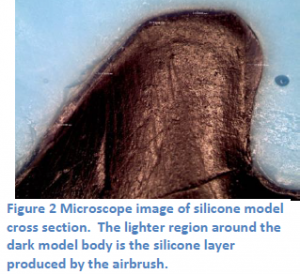Mitchell Hortin and Dr. Scott Thomson, Mechanical Engineering
Introduction
The purpose of this project was to develop a reliable method to create the epithelial layer of silicone rubber vocal fold models. The method needed be able to repeatedly create a uniform layer of silicone rubber that is 70-80 microns in thickness. The type of silicone rubber used was to have similar or identical properties to the type currently in use. In an attempt to accomplish this purpose, three types of nozzles, an ultrasonic mist maker and an airbrush were tested to see if they could efficiently atomize the silicone mixture. This testing showed that the airbrush setup has the most promise to accomplish our purpose.
Pneumatic Nozzles
One solution that was proposed and tested was a twin fluid pneumatic type atomizer setup that uses high velocity air to mix with a thin column of the silicone rubber mixture at a 90° angle, creating shear forces in the thin column of silicone, causing it to atomize. The simplest configuration was to place the air outlet and silicone outlet close to each other, termed external mixing

The tests with this setup showed that the droplets created by this method were too large for our applications. The difficulty in atomizing the silicone rubber mixture is its high viscosity, which is comparable to honey or syrup. In an attempt to produce smaller droplets, a nozzle was designed that causes the fluid and air to be mixed internally (see figure 1), while also introducing the air at a negative direction angle to create higher shear forces and produce smaller droplets. Each test with this setup showed through visual inspection that the droplets were too large and the spray was too directional.
Other Solutions
One other solution that was tested was a special nozzle called a Laskin nozzle. This nozzle type is actually submerged in the fluid, and forces air out horizontally at high velocity. This high velocity air jet creates low pressure areas, which force fluid down small channels and create vapor filled bubbles which then rise to the surface and release the vapor. This method created a lot of bubbles but failed to produce any vapor. An ultrasonic mist maker was also purchased and tested. These devices create vapor by vibrating a small plate at ultrasonic frequencies, which works very well with water, but failed to produce any vapor with the silicone rubber.
Airbrush

An airbrush was purchased in an attempt to atomize the silicone mixture with a more refined tool. This is basically the same external mixture configuration that was used from the very beginning but much more finely manufactured and assembled. Preliminary tests were run by spraying silicone models with the airbrush for predetermined amounts of time (on the order of minutes). These samples were then cut into slices and examined under a microscope (see figure 2), where it was possible to measure the thickness of the layers of silicone put down by the airbrush. It was seen that the layers were too thin for our application. We tried spraying the models directly for long periods of time. Using microscope examination it was seen that the direct spray resulted in a layer that was roughly the right thickness but was uneven. The specimens from the test chamber setup did not have any recognizable layers on them. The most recent approach involved using a smaller test chamber (see figure 3) with an impact plate to allow the spray to fill a smaller area, but tests of this method showed that no vapor reached the silicone model.
Conclusions and Future Work
In conclusion, we determined that the airbrush produced silicone layers that were either thin enough or thinner than our applications required. This method has the potential to work in model production, but still needs to be refined to a point that it can produce repeatable, uniform results.
The future work in this area can explore two different directions, direct spray or a vapor chamber style configuration with the airbrush. The direct spray method is the only method that has produced favorable results that can be measured; it also uses a minimal amount of silicone. The problem to solve with the direct spray is achieving a uniform layer thickness. This could be achieved by creating a mechanism that rotates and moves the models in such a way as to ensure an even application.
The vapor chamber configuration would produce more reliable, uniform results but we have yet to find a configuration that works. The challenge is creating enough vapor to deposit a thick enough layer on the models. The small test chamber configuration has promise, but perhaps a fan instead of an impactor plate could be used to diffuse the spray of silicone.

